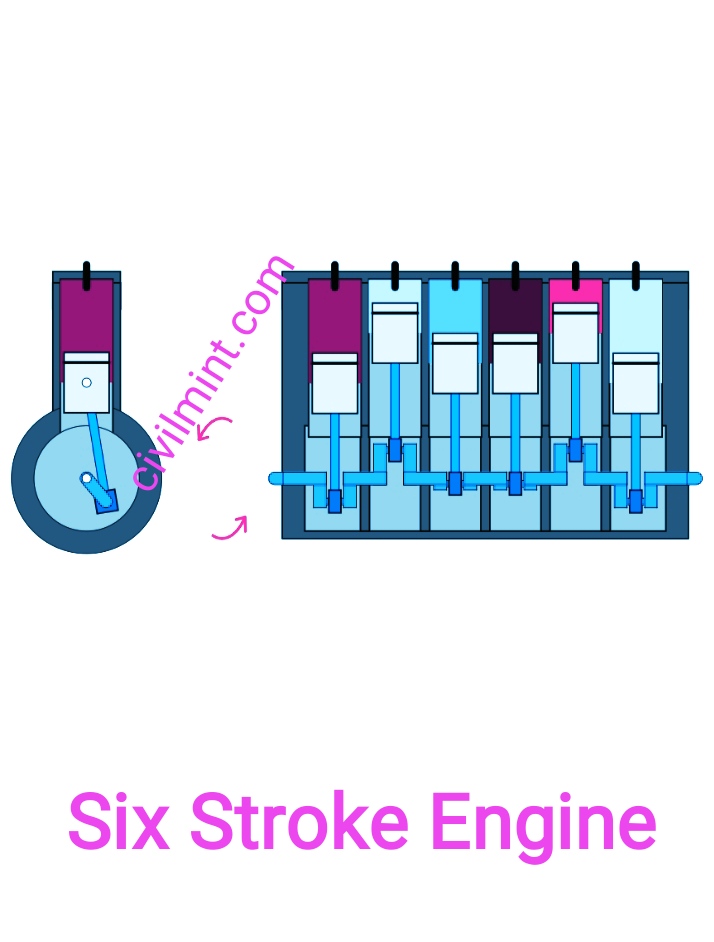The word 6 stroke engine has referred to many alternative internal combustion engine designs that seek to improve upon traditional 2-stroke and 4-stroke engines.
I also written an article on 2 stroke Vs 4 stroke engine. Check out this article to know the difference between 2 stroke and 4 stroke engine.
Claimed benefits may include improved fuel efficiency, reduced machine complexity, and reduced emissions. These engines can be divided into two groups based on the number of pistons contributing to 6 strokes.
In a single-piston design, the engine takes the heat lost from the four-stroke petrol or diesel cycle and uses it to drive the extra power and exhaust stroke of the piston in the same cylinder, improving fuel efficiency and improve the cooling system of the engine.
The piston in this type of 6-stroke engine goes up and down three times with each injection of fuel. These designs use steam or air as the working medium for the additional power stroke.
Designs where the six strokes are determined by the interaction of two pistons are more diverse. The pistons can be juxtaposed in a single cylinder or in separate cylinders.
Typically, one cylinder makes 2 strokes, the other 4 strokes, and 6 piston movements per cycle. A second piston can be used to replace the valve mechanism in conventional engines.
This reduces mechanical complexity and allows for higher compression ratios by eliminating compression-limiting hot spots. A second piston can also be used to increase the expansion ratio and decouple it from the compression ratio. Increasing the expansion ratio in this way can increase the thermodynamic efficiency, similar to the Miller and Atkinson cycles.
Table of Contents
How Does 6 Stroke Engine Work?
Six-stroke engines involves various steps within internal combustion engines to capture waste heat from the four-stroke Otto cycle and use it to generate additional flow and piston exhaust stroke.

This type of engine use both steam and air as working media for greater energy lift. Similar to power consumption, a larger stroke cools the motor and eliminates the need for a cooler. This makes the engine lighter and gives him a 40% improvement in overall performance compared to the Otto cycle.
The running of a 6-stroke engine is arranged by six exquisite strokes: Air intake, Air Exhaust, Exhaust stroke, energy stroke, Compression stroke, Suction stroke.
The 6-stroke engine describes some excellent processes within internal combustion engines that recover waste heat from the 4-stroke Otto cycle and use it to further modify piston power and exhaust stroke.
Advantages of Six Stroke Engine
- 6-stroke engines have slightly higher volume adjustment during the compression stroke than 4-stroke engines after the ports are closed.
- Strokes that occur are also much greater for him with 6 strokes than with 4. Each from TDC to BDC. There is also an open from the TDC to the exhaust port.
- 6 stroke engine avoid excess electricity from the extension stroke.
- Greenhouse gas degradation.
- Reduced gas usage.
- Reduce engine temperatures and eliminates the need for additional cooling frames.
Disadvantages
- High front-end charges due to replacement in device form.
- 6 stroke engine overcharge.
- 5th and his 6th stroke the engine has a larger stroke, which increases the engine estimate.
- Size can complicate packaging.
- Depending on the time of year, it may be difficult to bundle items together.
Closing Words
Six-stroke engines use various approaches in internal combustion engines to capture the waste heat from the four-stroke Otto cycle and use it to drive additional power and the exhaust stroke of the piston. The design uses steam or air as the working medium for the additional power stroke.
The 6-cylinder engine is a more powerful engine and is usually used in sports cars and automobiles that require more power. Six-cylinder engines are best used in vehicles with larger engines.
I hope you got some knowledge today.
Keep Learning!
Ta!Da! 😊
